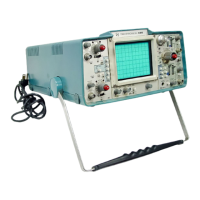Operating Instructions—455/A2/B2
Fig. 2-10. Time duration.
Example:
The horizontal distance measured is 8.3 divisions (see
Fig. 2-10). The TIME/DIV switch is set to 2 ms.
Fig. 2-11. Risetime.
2. Adjust the vertical POSITION control so that the dis
play bottom just touches the 0% graticule line and the dis
play top just touches the 100% graticule line (see Fig. 2-11).
Substituting the given values:
Time
Duration
Horizontal
distance x
(divisions)
TIM E/DIV
setting
Time
Duration
8.3
divisions x
2
ms/division
Time
Duration
16.6 ms
and
Frequency
1
time duration
Frequency =
1
16.6 ms
= 60 Hz
Risetime Measurements
Risetime measurements are made in the same manner as
time duration measurements, except the measurements
are made between the 10% and 90% points of the wave
form amplitude (see percentage markings on the left edge
of the graticule).
3. Measure the horizontal distance (divisions) between the
10% and 90% points on the waveform (point A to point
B, Fig. 2-11).
4. Use the following formula to find risetime:
Risetime
horizontal
distance
(divisions)
TIME/DIV
setting
Example:
The horizontal distance between the 10% and 90% point
on the waveform is 5 divisions with a TIM E/DIV switch
setting of 1 us.
Substituting the given values:
Risetime = 5 divisions x 1 //s/division
Risetime = 5 jus
Differential-Time Measurements
Very accurate time duration measurements can be made
using either the A Intensified or B Delayed modes.
Use the following procedure to measure risetime:
A INTENSIFIED DIFFERENTIAL TIME MEASURE
MENTS. Use the following procedure to make differential
1. Adjust the VOLTS/DIV and VAR controls for a dis- time measurements using the A Intensified mode,
play amplitude of exactly 5 divisions.
REV. A, OCT 1975
2-11

